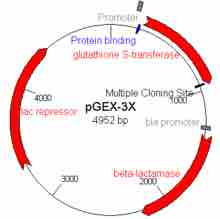An expression vector, otherwise known as an expression construct, is generally a plasmid that is used to introduce a specific gene into a target cell . Once the expression vector is inside the cell, the protein that is encoded by the gene is produced by the cellular-transcription and translation machinery ribosomal complexes. The plasmid is frequently engineered to contain regulatory sequences that act as enhancer and promoter regions and lead to efficient transcription of the gene carried on the expression vector. The goal of a well-designed expression vector is the production of large amounts of stable messenger RNA, and in extension, proteins. Expression vectors are basic tools for biotechnology and the production of proteins such as insulin, which is important for the treatment of diabetes.

The pGEX-3x Plasmid
The pGEX-3x plasmid is a popular cloning vector. Please note the presence of a multiple cloning site, a promoter, a repressor, and a selectable marker.
After expression of the gene product, the purification of the protein is required; but since the vector is introduced to a host cell, the protein of interest should be purified from the proteins of the host cell. Therefore, to make the purification process easy, the cloned gene should have a tag. This tag could be histidine (His) tag or any other marker peptide.
Expression vectors are used for molecular biology techniques such as site-directed mutagenesis. Cloning vectors, which are very similar to expression vectors, involve the same process of introducing a new gene into a plasmid, but the plasmid is then added into bacteria for replication purposes. In general, DNA vectors that are used in many molecular-biology gene-cloning experiments need not result in the expression of a protein.
Expression vectors must have expression signals such as a strong promoter, a strong termination codon, adjustment of the distance between the promoter and the cloned gene, and the insertion of a transcription termination sequence and a PTIS (portable translation initiation sequence).
A shuttle vector is a vector that can propagate in two different host species, hence, inserted DNA can be tested or manipulated in two different cell types. The main advantage of these vectors is that they can be manipulated in E. coli and then used in a system which is more difficult or slower to use.
Shuttle vectors can be used in both eukaryotes and prokaryotes. Shuttle vectors are frequently used to quickly make multiple copies of the gene in E. coli (amplification). They can also be used for in vitro experiments and modifications such as mutagenesis and PCR. One of the most common types of shuttle vectors is the yeast shuttle vector that contains components allowing for the replication and selection in both E. coli cells and yeast cells. The E. coli component of a yeast shuttle vector includes an origin of replication and a selectable marker, such as an antibiotic resistance like beta lactamase. The yeast component of a yeast shuttle vector includes an autonomously replicating sequence (ARS), a yeast centromere (CEN), and a yeast selectable marker.